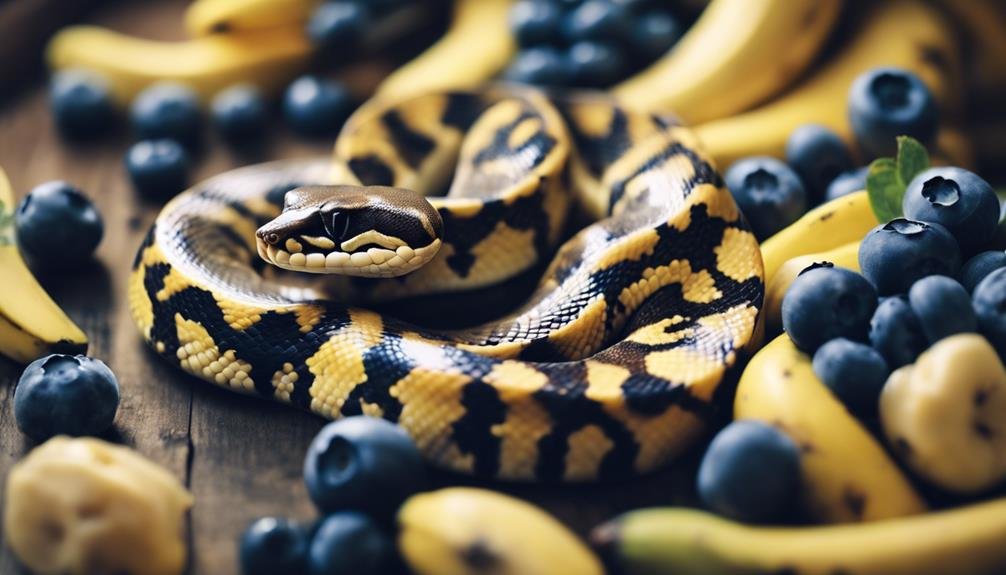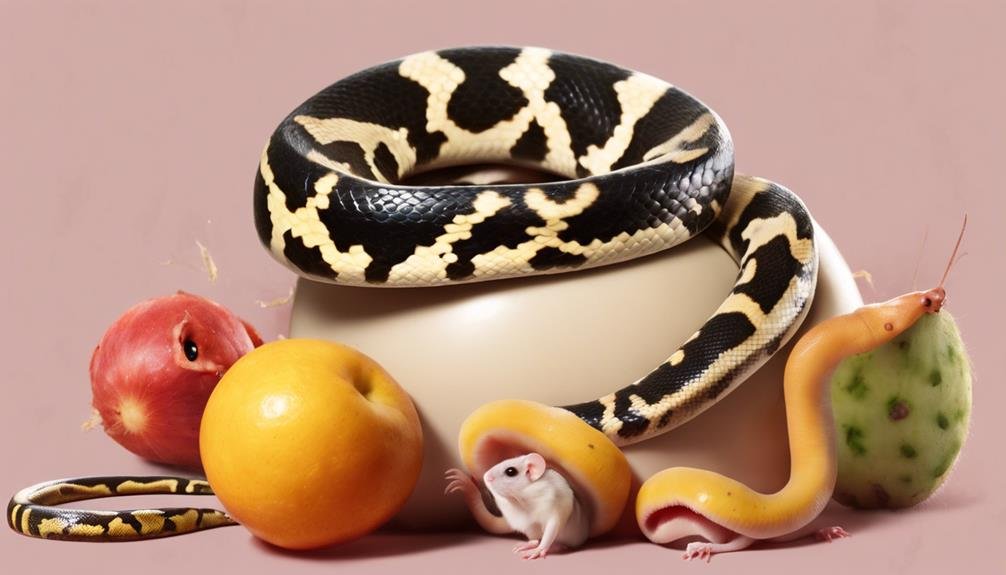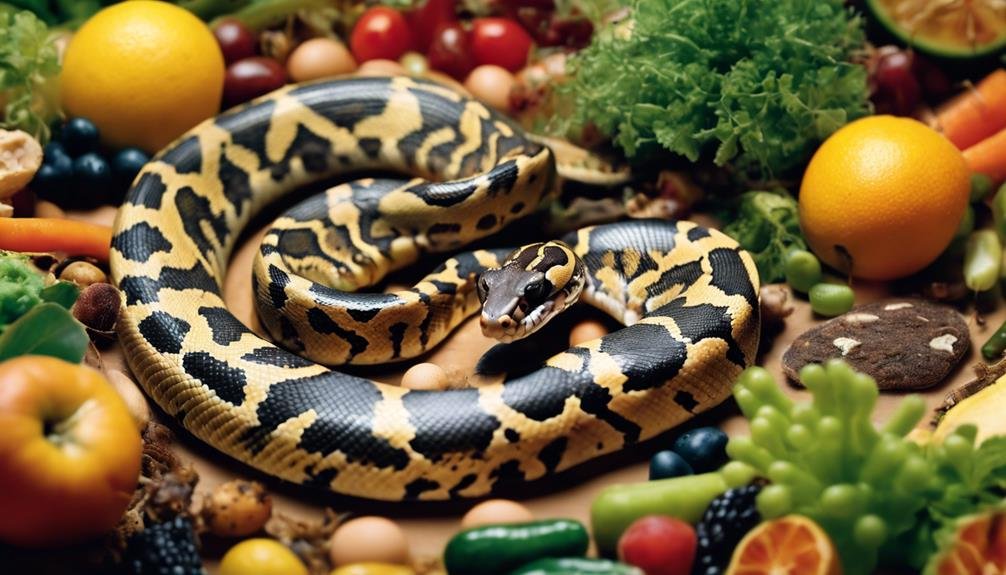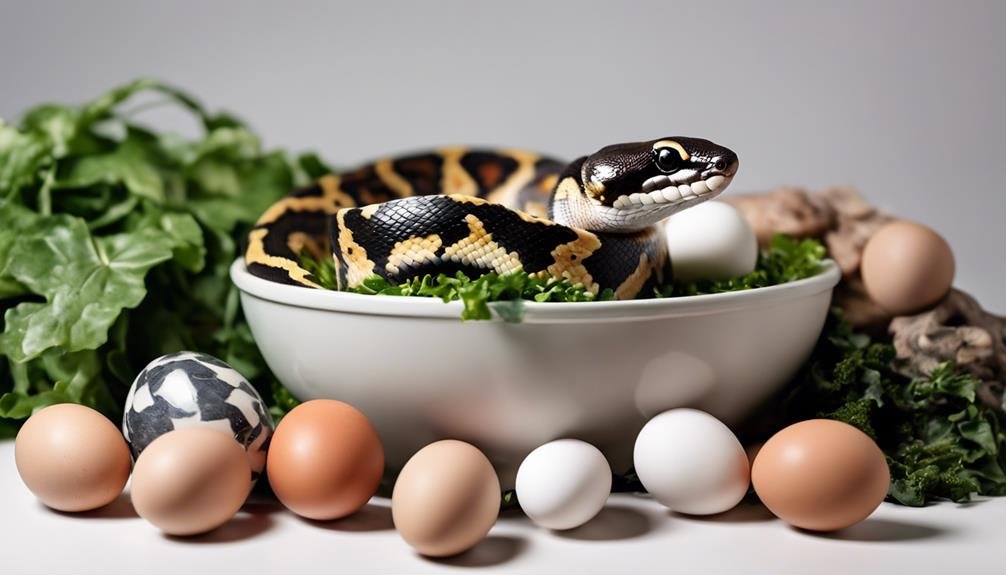As a ball python owner, you’re likely aware that your slithery friend’s diet is essential for its health and longevity. You know they thrive on a diet of rats, mice, and occasionally, treats like quail eggs, but understanding the specifics of what they can and can’t eat can be a complex task. Avoiding wild-caught prey and large items is just the tip of the iceberg. There’s a wealth of information on safe treats, essential supplements, and foods that could harm your pet, not to mention the signs of overfeeding. If you’re curious about how to strike the perfect balance in your ball python’s diet, there’s more to uncover that could have a significant impact on their well-being.
Key Takeaways
- Ball pythons can eat rats, mice, African soft-furred rats, chicks, and quail for a balanced diet.
- Quail eggs serve as nutritious treats in moderation for ball pythons.
- Avoid wild-caught prey and large prey items to prevent disease and digestive issues.
- Light dusting of calcium and multivitamins on prey can enhance nutrition but should be used sparingly.
- Varied diets prevent nutritional deficiencies and support overall health by mimicking natural feeding habits.
Ball Python Feeding Chart
To guarantee your ball python remains healthy and vibrant, it’s important to follow a structured feeding chart tailored to their age and weight. For hatchlings, you’re looking at feeding them every 5 days, making sure they’re getting all the nutrients they need during this rapid growth phase. As they progress into subadults and adults, weighing between 500-1500g, you can reduce feeding to every 2-3 weeks.
Your choice of prey items plays a vital role in their diet. Mice, domestic rats, quail, African soft-furred rats, and chicks are all suitable options that provide the necessary vitamins and minerals. While it’s not typically necessary to supplement their diet with extra vitamins or minerals, an occasional dusting of prey with a 50/50 mix of calcium and multivitamin powder can be beneficial.
Monitoring your python’s weight is important; use a digital kitchen scale for accuracy. Young snakes need weekly or bi-weekly weigh-ins, while adults require monthly checks. This helps make sure they’re not under or overfed.
Lastly, their enclosures should promote exercise and movement, including a large water bowl to replicate their natural habitat and erratic feeding habits. This combination of diet, weight monitoring, and an active environment supports their overall health and well-being.
Recommended Meats for Ball Pythons
Having established a feeding schedule, let’s explore the meats that best suit your ball python’s dietary needs. Rats, with their 21% protein and 11.1% fat content, stand out as a nutritionally complete option. They provide the right balance of protein and fat essential for your snake’s health. However, don’t overlook mice. Despite having 13% less protein and 30% less fat compared to rats, mice can still be a suitable food source, especially for younger or smaller ball pythons.
African soft-furred rats, offering similar protein levels to conventional rats, make a good alternative, although they might dig a bit deeper into your pocket due to their higher cost. For those seeking to introduce some variation, chicks are a high-protein option that can diversify your pet’s diet. In addition, quail eggs, rich in nutrients, can be given as a treat but should be offered in moderation due to their dense nutrient content.
Safe Treats and Supplements


Beyond the basic diet, you can enhance your ball python’s nutrition with safe treats like quail eggs and occasional supplements. Quail eggs, known for their nutritious value, make excellent treats when given in moderation. They’re packed with essential nutrients that can benefit your ball python, offering a nice change from their usual prey.
In terms of supplements, a light dusting of calcium and multivitamins on the prey before feeding can guarantee your snake is getting all the necessary nutrients. These supplements mimic the varied diet a ball python would have in the wild, filling any gaps in nutrition. However, it’s important to avoid overusing them. Snakes can survive without supplements, but offering them sparingly can prevent any nutritional deficiencies.
Foods to Avoid
While it’s beneficial to know what supplements and treats can enhance your ball python’s diet, it’s equally important to be aware of what foods you should avoid offering them. Certain foods pose risks of regurgitation, digestive issues, parasites, diseases, or even injury, detracting from your pet’s health and comfort.
Here’s a quick guide on what to steer clear of:
| Food Type | Reason to Avoid |
|---|---|
| Wild-caught prey | They might carry parasites or diseases. |
| Large prey items | Can cause regurgitation or digestive issues due to their size. |
| Insects | Lack the necessary nutrition ball pythons require. |
| Live prey | Risk of injury to your snake during feeding. |
Especially avoid giving your ball python prey items that are too large for comfortable consumption. This not only prevents potential regurgitation and digestive problems but also ensures that your pet remains safe and healthy during its feeding times. Remember, the goal is to maintain a diet that mimics their natural eating habits as closely as possible, without exposing them to unnecessary risks.
Signs of Overfeeding


You’ve learned what to feed your ball python, but it’s equally important to know the signs of overfeeding.
If your snake shows a sudden weight gain of 10% or more in a month or becomes lethargic, it’s time to reassess its diet.
These symptoms can lead to serious health issues, so keep an eye out and adjust feeding schedules as necessary.
Recognizing Weight Gain
Monitoring your ball python’s weight is vital, as sudden increases can indicate overfeeding. A clear sign of weight gain is when your python appears visibly rounder or wider, suggesting it’s time to reassess its diet.
Overfeeding doesn’t just affect their shape; it can lead to serious health issues like obesity and fatty liver disease, conditions that could compromise your pet’s well-being and lifespan. To avoid these problems, it’s important to adjust the feeding frequency and prey size based on your snake’s needs.
If you’re noticing signs of weight gain, consulting a reptile veterinarian can provide you with tailored advice on managing weight gain. They can guide you in adjusting feeding practices to ensure your ball python remains healthy and happy.
Behavioral Changes Indicators
After understanding how to recognize weight gain in your ball python, it’s equally important to identify the behavioral changes that may indicate they’re being overfed. Monitoring feeding schedules and adjusting portion sizes are vital steps to avoid these signs:
- Lethargy and Inactivity: If your snake becomes noticeably lethargic or inactive, it’s a clear sign of overfeeding.
- Regurgitation: Overfeeding can lead to regurgitation, which isn’t only unpleasant but also harmful to their health.
- Obesity Signs: A round body shape and difficulty moving are indicative of obesity, a direct result of overfeeding.
- Refusal of Food: An unusual refusal of food could signal that your ball python is being overfed and is no longer hungry.
Hydration Needs
Ensuring your ball python has constant access to a large water bowl is vital for its hydration and overall health. Proper hydration supports not just their digestion but also aids in preventing constipation—a common issue that arises from dehydration. It’s not just about having a water bowl in there; the water must be fresh and clean, encouraging your snake to drink regularly.
Monitoring the humidity levels within their enclosure is equally important to meet their hydration needs. Ball pythons thrive in environments that mimic their natural habitat, which includes adequate humidity to facilitate proper hydration through their skin as well. This delicate balance ensures they remain healthy and active.
Varied Diet Benefits


Introducing a variety of foods to your ball python’s diet isn’t just about keeping mealtime interesting; it’s vital for their health. By mixing up their meals, you guarantee they’re receiving a balanced mix of essential nutrients, avoiding dietary deficiencies.
Additionally, this approach can enhance their behavioral well-being, providing natural stimulation that mirrors their wild feeding habits.
Nutritional Balance Importance
Understanding the importance of nutritional balance is crucial, as a varied diet provides your ball python with all the essential nutrients it needs to thrive. By integrating a mixture of prey items into their meals, you’re not only catering to their physical health but also guaranteeing their diet closely mirrors their natural feeding habits in the wild.
Here are four key benefits of varied diets for your ball python:
- Prevents Nutritional Deficiencies: Guarantees a balanced intake of proteins, fats, vitamins, and minerals.
- Diverse Nutritional Profiles: Different prey items contribute uniquely to their overall health.
- Combats Picky Eating: Rotation of prey discourages finicky habits.
- Mimics Natural Feeding: Offers a diet that resembles what they’d encounter in their natural habitat, promoting well-being.
Behavioral Enrichment Through Diet
Frequently varying your ball python’s diet not only combats picky eating but also enriches its life by stimulating both mental and physical activity. By introducing a varied diet, you’re offering enrichment that mimics their natural feeding habits, which includes a mix of prey items like quail eggs and chicks. This variety not only prevents picky eating behaviors but also provides essential nutrients for their overall health, ensuring a balance that supports both mental and physical well-being.
| Prey Item | Benefits |
|---|---|
| Quail Eggs | Nutritional Diversity |
| Chicks | Mimics Natural Diet |
| Variety | Behavioral Stimulation |
Incorporating these items into your python’s diet can greatly enhance their quality of life through behavioral stimulation and a more engaging feeding experience.
Reptile Care Resources
For ball python owners seeking guidance, Zen Habitats offers extensive care resources, including detailed feeding guides and nutritional information. These resources are specifically designed to support you in providing the best care for your ball python, focusing on its health and well-being.
To make sure you’re fully equipped, here’s a breakdown of what Zen Habitats provides:
- Feeding Guides and Nutritional Information: Understand what your ball python needs to thrive, including the variety of meats and treats suitable for their diet and those to avoid.
- Monitoring Weight and Health: Learn the importance of regularly checking your ball python’s weight and signs of good health to catch any potential issues early.
- Enclosures and Accessories: Discover enclosures and accessories that cater to the specific needs of ball pythons, ensuring they’ve a comfortable and stimulating environment.
- Replicating Natural Feeding Behaviors: Gain insights into how to mimic natural feeding behaviors in captivity, promoting a healthier and more content ball python.
Additionally, Zen Habitats’ community forum is a valuable resource where you can share experiences, seek advice, and connect with other ball python owners. Explore these reptile care resources to enhance your ball python’s quality of life.
Can Avoiding Certain Foods Prevent Ball Pythons from Biting?
Some believe that specific foods can affect ball python bite pain levels. While diet may impact a snake’s temperament, there is no evidence to support avoiding certain foods as a method of preventing bites. Proper handling and regular interaction are more effective in reducing ball python bite incidents.
Frequently Asked Questions
What Treats Can Ball Pythons Eat?
You’re curious about treats for your ball python? Great choice! Quail eggs and chicks can spice up their diet, offering essential nutrients.
However, don’t forget the basics: monitor their feeding frequency, adjust for temperature changes, guarantee a clean water dish, and consider nutritional supplements.
Vary the feeding technique and prey size, handle carefully post-feeding, tweak during their shedding cycle, and enrich their habitat for their well-being.
These practices guarantee a happy, healthy snake.
Can I Feed My Ball Python Meat?
Yes, you can feed your ball python meat, focusing on mice, rats, and other small animals. It’s important to match the prey size to your python’s size and opt for frozen over live to guarantee feeding safety.
Aim for a variety in their diet to meet their nutritional needs, offering food every 1-2 weeks depending on age. Avoid high-fat meats and consider dietary supplements to support their digestive health and overall well-being.
What Can I Feed My Ball Python Besides Rodents?
You can diversify your ball python’s diet with alternative prey options like quail, chicks, and African soft-furred rats. Consider the prey’s size and your snake’s nutritional needs, including supplements.
Feeding frequency and a varied diet are key to preventing picky eating. Choose between live and frozen based on ethical practices and safety.
What Kind of Snacks Can You Give a Snake?
You can give your snake snacks like quail eggs, but remember to do so sparingly. Always follow safe handling practices and monitor their weight to prevent health issues.
Adjust their feeding frequency according to seasonal changes and guarantee their vivarium’s set up supports their hydration and shedding needs. Consider prey size carefully and introduce nutritional supplements if needed.
Offering environmental enrichment is also key to keeping your snake healthy and active.
Conclusion
To sum up, you’ve got a range of options to keep your ball python healthy and satisfied. Stick to recommended meats like rats and mice, and occasionally mix in treats like quail eggs for extra nutrients. Avoid wild-caught prey and large items to prevent issues.
Keep an eye out for overfeeding signs and always make sure they’re well-hydrated. A varied diet not only supports their health but keeps them interested.
Explore reptile care resources for more tips to help your python thrive.


